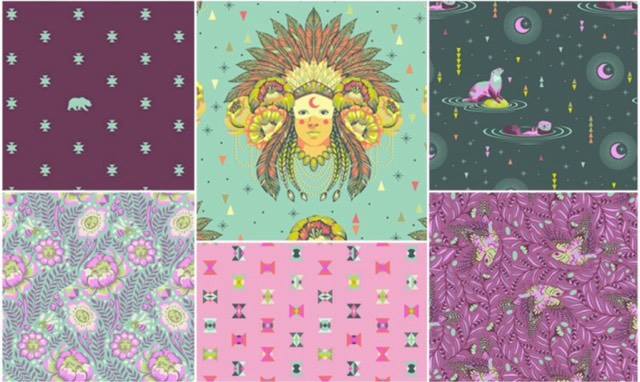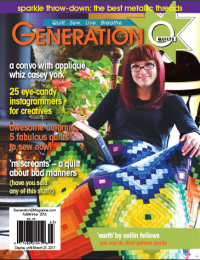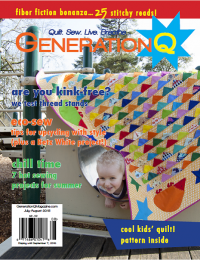
Some of the prints in Tula Pink’s Spirit Animal collection by FreeSpirit Fabrics, debuting later this year. Note: The top center print has been removed from the collection, due to controversy.
By the Generation Q Magazine staff
There are many brou-ha-has broiling on Facebook of late (eye roll), but the one involving uber-popular Tula Pink and her soon-to-be-released collection of Native American-themed prints has really grabbed our hearts.
Tula’s Spirit Animal collection by FreeSpirit Fabrics is scheduled for release in September. The main print in the collection showcased (note use of past tense) a luscious, beautifully illustrated Native American figure wearing a traditional feather headdress.
The problem arose when some people (we’re not sure if they are Native American tribal members themselves or friends of members or simply concerned citizens) posted on Tula’s Facebook page that they were upset with her usage of the head-dressed Native American on her centerpiece fabric. They insisted she not use this fabric in the collection, and accused her of cultural misappropriation.
The premise behind their complaint is that Tula does not have the right to use the image of the headdress, which is a revered traditional symbol among some Native American tribes and, we’re told, is only used by those who have earned the right to wear a headdress. Tula’s use of this image is a desecration to Native American tribes concerned with protecting their cultural heritage and traditions. Tula, these critics said, should not be using this image at all.
So, here’s a problem: Tula is herself of Native American ancestry. How much and to what extent we don’t know, but it was her pride in her heritage that led her to design this collection in the first place. Through its prints, she is telling the story of and celebrating her background. As artists have done, oh, forever.
And here’s another problem: The way this very small group of naysayers approached and attacked Tula over her art, which led her to pull the main fabric out of the collection altogether. About a dozen people posted their angst over the fabric on Tula’s Facebook page, and some were far more strident than others. Here’s just one:
“It’s disheartening to see yet another textile company using sacred imagery to be trendy. I hope you really absorb the words of the people whom you have hurt. I look forward to seeing the announcement that production of this cultural MISappropriation will be swiftly halted,” writes Sasha Boaz on Facebook.
This gang mentality, complete with name-calling and accompanied by Internet links to articles on extreme websites explaining and opposing cultural misappropriation, is a classic example of bullying, via social media in this case.
There is no place in our Q-niverse for bullies or bullying. In any form. From any source. For any reason.
While concerns over the use of cultural imagery may be valid, where have those concerns been for the past two years+ as fabrics and patterns with teepees and arrows have trended in the marketplace? Where has the outrage over sugar skulls been? They are culturally significant in Mexican culture. How does this “cultural misappropriation” affect the Nordic designs that (spoiler alert!) will be trending at the upcoming Spring International Quilt Market? There are many cultures in our world. How do we decide if an act of art celebrates a culture or merely profits off its imagery?
This whole issue seems to have been poorly handled. Apparently, none of the complainants actually asked Tula about her artistic decisions. She was figuratively tarred and feathered (pun intended) with little chance to speak for herself. Except that after she published her eloquent response on Facebook, and gave her reasons for pulling the fabric, more than 1,000 people wrote in support of her, many begging her to put the fabric back into the collection. She demurred.
“I am proud of my father’s heritage and am grateful for the richness of culture that he passed onto me. I wanted to honor that crucial part of myself in the same way that I had in previous collections. I am saddened that I have to defend this here and in this way,” she writes.
Because her art is the way she shares her thoughts and feelings–and not a vehicle for making people uncomfortable–she writes that she has asked FreeSpirit to pull the main print from this collection. But there is price.
“I have chosen not to replace this print but to let it stand as is with a piece of its heart missing,” she concludes.
FreeSpirit Fabrics, which manufactures Tula’s designs, is planning to release a corporate statement on this controversy at some future point. However, FreeSpirit’s marketing official Nancy Jewell says that to the best of her knowledge, this is the first time anything like this has ever happened at the company.
Now it’s time to step back a little. When we gather up the pitchforks to point out a perceived wrong in the marketplace, we really need to look at the larger picture. Are we raising awareness in the industry as a whole? Or are we making one person stand trial for the wrongs of a nation? And, honestly, who died and made us the (Cultural Image) Quilt Police?
What’s saddest is that there is room for discussion and education on the core issue of when art should yield to protecting cultural heritage and tradition. Why shouldn’t we honor and respect the wishes of those who claim ownership of symbols that are important to their group? Unfortunately, when discussions about protecting cultural imagery are shouted down by uncivil confrontation, it takes everyone who cares out of the conversation.
So here’s one more question for debate: Is there a dotted line dividing cultural misappropriation and inspiration? When does protectionism overrule the mystery of creative vision and an artist’s freedom to create?
Now that’s a conversation worth having.
Quilt. Sew. Live. Breathe.







COMMENT #1
“cultural theft” is flat out rubbish. Tula isn’t pretending to be Indian, unlike some politicians whose names will remain unmentioned. Also, if one looks into it further, one discovers that Indians don’t tend to call themselves “native Americans”, that’s actually not nomenclature of their own cultural identity.
COMMENT #2
You said it all so eloquently!!! I knew of this fiasco last week and as a former fabric designer (retired now), my heart grieved for Tula! She wanted to move forward, so she pulled the fabric, and rightly so said there was a gaping soul in the line. Social media has unfortunately become an nearly anonymous forum for adult bully’s to be heard. I look forward to Free Spirit’s statement.
COMMENT #3
It sounds like it was the use of the ornamental headdress which sparked the controversy. Perhaps the discussion should begin there. Maybe taking smaller steps on this long and winding path will help us all along the way. I have seen comments from both sides of this issue that made me cringe a little, but I do believe that everyone is coming from a good place; the anti’s want to preserve a fragile culture, the pros want to support an artist they love and admire. Education and understanding from all is needed.
COMMENT #4
I believe you may have meant to say “with” instead of “without” in the sentence about being tarred and feathered. That being said, I believe it is not people’s right to criticize without knowing motive, history, intent, etc. People just need to be kinder and gentler and give others space to create. There are no new patterns under the sun and we are always reusing in new and different and exciting ways. I do not understand this incessant need to criticize and tear people apart, and I do not believe people should give in to this noise. Truth should rise, the loudest and longest rant should not.
COMMENT #5
So well written and such great food for thought. When I first became aware of this (after she had pulled the design and people on Instagram came out in support of her and her design), my first thought was where is all this controversy for other cultural symbols (Asian, European, African, etc.) that have been featured in fabric collections for ages? I am so disappointed in the manner in which people think it’s appropriate to air their grievances and disagreements. Thanks for posting this thoughtful response!
COMMENT #6
An image of a Native person is not a “spirit animal.” You should consult Native people versed in visual and cultural theory before issuing a statement such as this, because it comes off as being dismissive to Native Americans, and to cultural appropriation.
COMMENT #
Jennine, if you re-read the piece, you will note that we never called anything “spirit animal.” That is the formal name for Tula’s collection of fabrics. And we did not need to consult with “Native people versed in visual and cultural theory” because they came to us, in small droves, on Facebook. So we’ve heard the points and still disagree with the manner in which their concerns were delivered. Any movement intent on education should be open and willing to be questioned about their philosophy, and it should answer those questions. We’re not hearing answers to our questions, which were thoughtfully crafted and allow room for a change of heart. Those are the main issues here: the bullying approach and the lack of intercourse on the idea of cultural misappropriation.-Jake
COMMENT #
Hi Jake- I’m curious where the comments are from the “small droves” you mentioned? I’ve not seen many other comments on the Facebook page or here. Thank you.
COMMENT #
Hi Holly: We initally saw and read far more comments on Tula’s page than we see there now. It’s possible she took them down or that there were so many others that they scrolled to the bottom, but I do know there were at least a dozen different people posting on her personal page and we read each one. As it’s Tula’s personal page, we have no access or control over it beyond what shows.
COMMENT #
Hi Jake-
When you said: “And we did not need to consult with “Native people versed in visual and cultural theory” because they came to us, in small droves, on Facebook.” That gave me the impression that YOU/Generation Q were contacted.
COMMENT #7
I wonder if this is engaging in the wrong discussion. Perhaps the discussion should be if there is a difference in the cultural expectations and social norms with respect to how, where, and why an artist expresses herself. If there is a difference, then the issue is not about what symbols are on the fabric, but what an artist is allowed to do within the confines of a culture.
COMMENT #8
It seems to be bullying, in my opinion. Frankly, it makes me think those tribal entities are just wanting money. It is a beautiful design, and is suitable for everyone to use. I do not believe it representative of any one tribe, and the only one that can claim ownership of this design is Tula Pink.
COMMENT #9
My thoughts are much like those above: what about the aboriginal designs of all the Australian fabrics that were so popular 15 years ago? Or the Nordic designs that come from my own heritage. The thought of someone using old Viking symbols or designs on fabric does not upset me. I love the inspiration and I would definitely buy it!
I have a feeling that these native designs don’t upset actual Native Americans–just the self-righteous people who feel it’s necessary to speak for an entire ethnic group, of which they may not even be a part! It upsets me that a few loud-mouths with a misguided sense of justice or “fairness” or whatever, could cause such a ruckus.
Thank you for some common sense.
COMMENT #
Agree
COMMENT #
I definitely agree!
COMMENT #
This is what popped into my mind after reading your comment. People don’t tend to speak out about the use of Nordic, Asian or Mexican symbols on fabric (or in art) because Americans didn’t do anything overtly bad to those cultures. Sure, there were wars and such, but not like what was done to the Indians in America, which was on par with a holocaust.
The early settlers did their best to purge Indians from the country, isolated what was left of them on reservations (not so different from concentration camps except they’re free to leave), and forced assimilation into the American White culture onto their youth.
Just as we would be outraged to see fabric bearing neon swastikas, perhaps the ones making a stink do so because seeing the symbol of the original Americans taps into some deeply-buried guilt complex that they carry. It may be a reminder to them of what the white man did to the Indians when they came, and they don’t want to have to see that on someone’s quilt at the county fair because it would bring up too much guilt.
COMMENT #10
Generation Q Editorial Staff-
The tone of your editorial startled me. I recognize that it is an editorial and therefore subject to opinion, but it came across as condescending. There is plenty of room for discussion and there should be discussion, but your article felt like you were shaming anyone who disagreed with you and that’s probably not the best way to encourage discussion.
Sadly, there were a lot of rude and aggressive comments about Tula Pink’s pulled design from people on both sides of the issue. It seems that you place the burden of ugly behavior solely on the side you disagree with. The “gang mentality and name calling” occurred on both sides of the argument. Your Facebook post about your article even has someone referring to “the jealous bitches” who wanted the design pulled.
This is a polarizing topic and personally, I had to spend some time thinking about it. If you had to choose iconic images that represented Native Americans, what would they be? Tepees? Bow and arrow? The war bonnet? But what tribes do these belong to? Not all tribes used war bonnets, it’s just an image that we’ve latched on to because of the predominant use of it in movies and art that involved Native Americans but was rarely BY Native Americans. What if someone designed a line of fabric with stereotyped African American iconography? Would you feel uncomfortable if Aunt Jemima was on fabric?
The gut reaction to defend Tula’s design is that society sees the headdress as an item of glory and beauty- and it is, but it’s not society’s to take and use and the more we see that imagery, the more we continue to perpetuate an inaccurate stereotype. I do not think it is okay for a concert-goer to wear an Indian headress to Coachella (Google this if you are unfamiliar) and I think it is equally disrespectful to see that image on someone’s handmade diaper bag or zipper pouch. Tula’s design was far more than an illustration on a piece of paper, it was about to go into production on thousands of yards of fabric. If Tula Pink wanted to showcase her heritage and honor her father, she has the platform to do so and open up a dialogue about the history, meaning and spirituality behind her designs. But to put a generic (is it generic? Or is it designed with historical and cultural accuracy?) image on fabric that then goes into the hands of people who may or may not care about what it is truly supposed to represent, is appropriation. It doesn’t matter if she has Native American blood in her veins.
Our society has a long way to go with paying attention to how we stereotype other cultures and how we appropriate iconography. The fabric industry is no different and while Tula Pink’s situation definitely burst open the topic on a larger scale there are many out there that have been reaching out to the fabric companies to encourage more diversity in fabric designs as well as to recognize when something is appropriation. They just haven’t been heard until now. So, let’s keep having those discussions about sugar skulls and Madonna imagery and tepees.
You also made the assumption that the “naysayers” are a small group and indicate that only about a dozen people dissented on Tula’s Facebook post. There is a much larger group of us out there, included those who are eloquent , well spoken and not bullies. I imagine many didn’t feel comfortable commenting on your article due to its tone but we are out there and we are discussing this.
COMMENT #11
I’m so glad y’all are against bullying. I’ve edited your article to align with that goal…
TITLE: Growth is hard, but necessary.
CAPTION: Some of the prints in Tula Pink’s Spirit Animal collection by FreeSpirit Fabrics, debuting later this year. Note: The top center print has been pulled by Tula Pink from the collection, after input from the quilting community.
BODY: Tula’s Spirit Animal collection by FreeSpirit Fabrics is scheduled for release in September. On April 4th, the fabric designer announced that she had asked her manufacturer to pull the main print in the collection; the print depicts a young person wearing a traditional feather headdress.
After educating ourselves on issue of cultural appropriation in general, and the treatment of Native American culture(s) in particular, we stand in support of Pink in her decision to pull the print. We applaud the members of the quilting community who spoke with her respectfully and honestly about her images, and we hope for continued growth of this kind in the quilting industry.
COMMENT #12
wow, i am really kind of shocked at how tone deaf this article is. I have read opinions on both sides of this argument but this really takes the cake for insensitivity. Comparing American Indians to the nordic people really? because the nordic people were displaced, and stolen from their families and forced in to schools. If the face in the fabric was african american, or asian would you still think it was okay? I dont fault Tula for her design, she gets to design and I and other quilters can chose to buy it or not, but your so called defense of her does more harm than good.
COMMENT #
Yep, you get it. I agree with you.
COMMENT #13
{“It’s disheartening to see yet another textile company using sacred imagery to be trendy. I hope you really absorb the words of the people whom you have hurt. I look forward to seeing the announcement that production of this cultural MISappropriation will be swiftly halted,” writes Sasha Boaz on Facebook.
This gang mentality, complete with name-calling and accompanied by Internet links to articles on extreme websites explaining and opposing cultural misappropriation, is a classic example of bullying, via social media in
this case. } I’m not clear where Ms. Boaz’s remark demonstrates gang mentality and bullying. I think it was a really respectful commentary and does not deserve characterization in that way. This editorial seems like a knee jerk reaction in support of one of the quilting gliterati. Art gets criticized. She didn’t have to pull the design – she could have stood in support of it, as could Free Spirit (who notably has not had a response in support of their designer). Gosh, if every artist who was criticized ran and hid, the Louvre would be half empty.